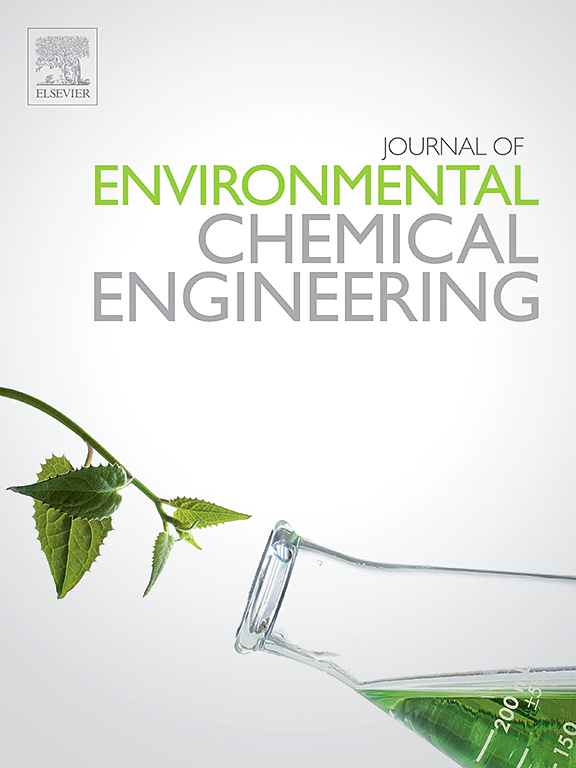功能化高分子复合膜在污水处理中的应用综述
IF 7.2
2区 工程技术
Q1 ENGINEERING, CHEMICAL
引用次数: 0
摘要
对高效废水处理技术的需求不断增长,导致了改性聚合物复合膜的发展,提供了更好的分离性能,耐用性和抗污染能力。这些膜将基础聚合物与功能性添加剂或涂层结合在一起,解决了传统聚合物膜的局限性,如污垢、低选择性和有限的机械稳定性。基础聚合物,包括聚醚砜(PES)、聚偏氟乙烯(PVDF)和聚砜(PSF),由于其化学和机械性能而被用作基础材料。添加剂,如纳米材料(如氧化石墨烯,碳纳米管),无机填料(如tio2, ZnO)和生物聚合物(如壳聚糖,纤维素)的加入,以增强功能。各种改性技术,包括共混、逐层组装、化学接枝和表面涂覆,都可以改变膜的特性,如亲水性、孔隙度和防污能力。改性膜应用于各种过滤过程,包括微滤、超滤、纳滤和反渗透,以实现悬浮物、重金属、染料和有机污染物的有效去除。最近的创新集中在防污、吸附和光催化膜上,这些膜表现出卓越的性能和寿命。尽管取得了重大进展,但可扩展性、长期稳定性和环境影响等挑战仍然存在。未来的方向强调发展环保材料,可持续的制造方法,以及具有自清洁或响应特性的智能膜。这些膜与其他处理技术的集成,如高级氧化工艺,可以进一步提高废水处理效率。综述了污水处理用改性高分子复合膜的制备方法、材料创新及应用进展。本文章由计算机程序翻译,如有差异,请以英文原文为准。
A comprehensive review of the functionalized polymer composite membranes in wastewater treatment
The growing demand for efficient wastewater treatment technologies has led to the development of modified polymeric composite membranes, offering improved separation performance, durability, and resistance to fouling. These membranes integrate base polymers with functional additives or coatings to address the limitations of conventional polymeric membranes, such as fouling, low selectivity, and limited mechanical stability. Base polymers, including polyethersulfone (PES), polyvinylidene fluoride (PVDF), and polysulfone (PSF), serve as foundational materials due to their chemical and mechanical properties. Additives such as nanomaterials (e.g., graphene oxide, carbon nanotubes), inorganic fillers (e.g., TiO₂, ZnO), and biopolymers (e.g., chitosan, cellulose) are incorporated to enhance functionality. Various modification techniques, including blending, layer-by-layer assembly, chemical grafting, and surface coating, allow the tailoring of membrane properties such as hydrophilicity, porosity, and antifouling capabilities. Modified membranes are applied across various filtration processes, including microfiltration, ultrafiltration, nanofiltration, and reverse osmosis, to achieve efficient removal of suspended solids, heavy metals, dyes, and organic pollutants. Recent innovations focus on antifouling, adsorptive, and photocatalytic membranes that exhibit superior performance and longevity. Despite significant advancements, challenges such as scalability, long-term stability, and environmental impact persist. Future directions emphasize the development of eco-friendly materials, sustainable fabrication methods, and smart membranes with self-cleaning or responsive properties. The integration of these membranes with other treatment technologies, such as advanced oxidation processes, could further enhance wastewater treatment efficiency. This paper reviews the preparation methods, material innovations, and application advancements in modified polymeric composite membranes for wastewater treatment.
求助全文
通过发布文献求助,成功后即可免费获取论文全文。
去求助
来源期刊

Journal of Environmental Chemical Engineering
Environmental Science-Pollution
CiteScore
11.40
自引率
6.50%
发文量
2017
审稿时长
27 days
期刊介绍:
The Journal of Environmental Chemical Engineering (JECE) serves as a platform for the dissemination of original and innovative research focusing on the advancement of environmentally-friendly, sustainable technologies. JECE emphasizes the transition towards a carbon-neutral circular economy and a self-sufficient bio-based economy. Topics covered include soil, water, wastewater, and air decontamination; pollution monitoring, prevention, and control; advanced analytics, sensors, impact and risk assessment methodologies in environmental chemical engineering; resource recovery (water, nutrients, materials, energy); industrial ecology; valorization of waste streams; waste management (including e-waste); climate-water-energy-food nexus; novel materials for environmental, chemical, and energy applications; sustainability and environmental safety; water digitalization, water data science, and machine learning; process integration and intensification; recent developments in green chemistry for synthesis, catalysis, and energy; and original research on contaminants of emerging concern, persistent chemicals, and priority substances, including microplastics, nanoplastics, nanomaterials, micropollutants, antimicrobial resistance genes, and emerging pathogens (viruses, bacteria, parasites) of environmental significance.
 求助内容:
求助内容: 应助结果提醒方式:
应助结果提醒方式:


